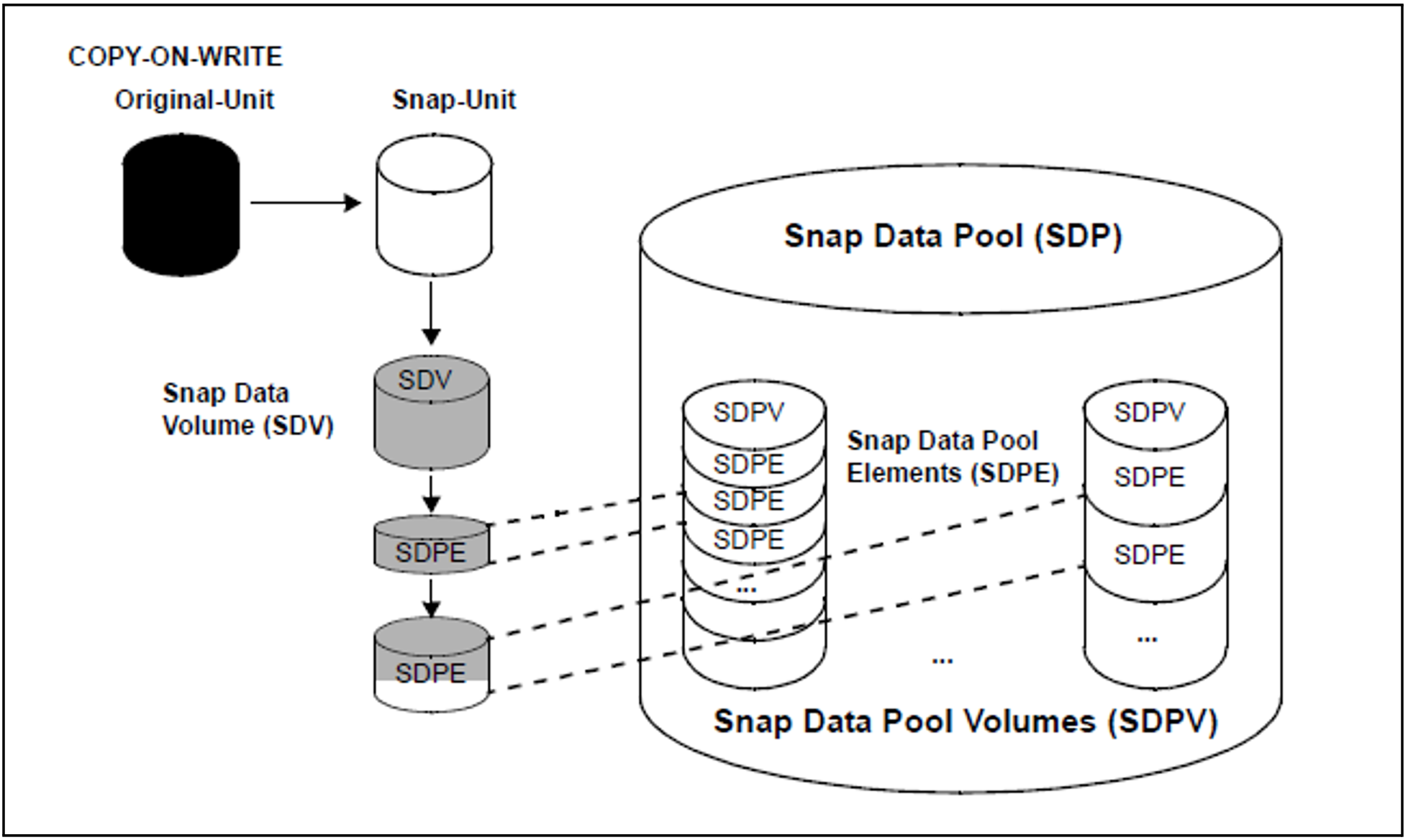In this case, SnapOPC+ uses specially configured devices in the storage system, which are known as Snap Data Volumes (SDVs), as snap units. The volume type D3435 is supported in BS2000 for SDVs.
A sufficient number or size of SDV must be available. The recommendation for new snapshots is to use free choosable snap units. The advantages is more flexibility and they are easier to handle.
SDVs are configured and initialized in the storage system by a qualified technician. SDVs can also be accessed from the server.
The capacity of the SDVs can be specified when they are configured. By default SDVs are configured with a capacity of 25 MB + 0.1% of the capacity of the original unit.
Recommendation
Configure the SDVs with a capacity which will presumably be required in operation. In the storage system an estimation function provides a clue here.
SDVs cannot be used as an original unit for other replication functions.
An SDV initially uses its configured capacity for data storage. If the capacity of the SDV has been exhausted, it is provided with further capacity from a central storage area (Snap Data Pool, SDP) of the storage system, see figure 15.
SHC-OSD checks the total capacity of an SDV when a snap session is created. It must be greater than or equal to the capacity of the original unit.
It is recommended that SDVs always be operated with the Snap Data Pool. Otherwise the SDV must always have sufficient capacity.
Snap Data Pool Volumes (SDPVs), Snap Data Pool Elements (SDPEs), Snap Data Pool (SDP)
If the capacity of an SDV has been exhausted, because of the "Copy-On-First-Write strategy" further changes are stored in so-called Snap Data Pool Volumes (SDPVs).
SDPVs provide the SDVs with temporary storage space in the form of multiple Snap Data Pool Elements (SDPEs), see figure 15. The temporary storage space made available for an SDV can be located on more than one SDPV. It is released again when the snap session is terminated (= cancelation of the snap pair with /STOP-SNAP-SESSION).
SDPVs are volumes in the Snap Data Pool (SDP) of the storage system.
SDPVs are partitioned in units of 1, 2 or 4 GB, the so-called Snap Data Pool Elements (SDPEs).
SDPVs are configured and initialized in the storage system by a qualified technician. The SDP is also configured implicitly and the SDPV is assigned to the SDP.
The specifications for save pools in the SHC-OSD parameter file (PRESELECTED-SAVE-POOL and SAVE-POOL-SATURATION parameters) and in the commands /START-SNAP-SESSION (SAVE-POOLS operand) and /MODIFY-SHC-PROCESSING (SNAP-SAVE-POOL-SAT operand) have no meaning for ETERNUS DX/AF.
The available capacity of the SDP is determined by the size and number of its SDPVs and is consequently limited. The required capacity must therefore be planned carefully in advance.
The required capacity depends on the following factors:
Data volume of the applications for which snap sessions are to be generated
Number of snap units per original unit
Change volume on the original unit (and the associated snap units)
CAUTION!
When the SDP is full (overflow), the existing snap sessions can only be continued until the snap unit's capacity limit is reached. After that they can only be terminated. The data modified on the snap units is then lost. The SHC-OSD functions for monitoring save pools should therefore be used.
Figure 15: Concept of the Snap Data Pool (ETERNUS DX/AF) Areas shaded gray show the current occupancy level of SDV and SDPV.
Monitoring the SDP
SHC-OSD offers monitoring of the occupancy level of the SDP for ETERNUS DX/AF. The /SHOW-STORAGE-CONFIGURATION INFORMATION=*SAVE-POOLS command (see "SHOW-STORAGE-CONFIGURATION Displays the configuration") displays information on the SDP with details of the current occupancy level and alarm status. In addition, the messages NDE0057 through NDE0059 (which you can answer) on the console show when a particular limit value for the occupancy level of the SDP has been exceeded.
The limit values for the various alarm statuses (ATTENTION, WARNING, CRITICAL) are set in the storage system and cannot be modified with SHC-OSD means. Default limit values: ATTENTION: 50% of the available capacity used; WARNING: 70%; CRITICAL: 99%.
When a limit value is reached, administrative intervention enables additional capacity to be provided again in the SDPl. Old snap sessions which use the SDP and whose data has been saved can be terminated (/STOP-SNAP-SESSION). Alternatively, the SDP can be extended in the storage system. When sufficient space is once more available in the SDP (alarm status NORMAL), this is indicated by the message NDE0053 on the console. Unanswered messages NDE0057 through NDE0059 are then answered automatically.

